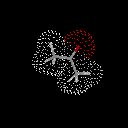





|
I. Name ionic
compounds
A. Naming compounds with type I
cations-type I cations are cations that have one possible
charge.
All the elements in the first two families
form type I cations. A few of the elements in groups 3
though 13 form only one cation; therefore, a few of
them are type I cations-examples include
Ag+, Cd2+, Zn2+, and
Al3+.
The cation is named first.
If the cation is a "simple" cation
("simple" ion is made from only one element.) the
cations is named after the element.
If the cation is a polyatomic cation (a
polyatomic ion is made from two or more covalently
bonded elements.) you use the name that you have
memorized (however, since we only talk about a
couple of polyatomic cations this should not prove
to be too difficult. NH4+ is
the ammonium ion. The Hg22+
cation is a polyatomic ion and a type II
cation.).
The anion is named second.
If the anion is a simple ion it takes its
name from the root name of the element , and
"-ide " is added.
If the anion is a polyatomic anion you use the
name that you have memorized.
NaCl, MgCl2, AlCl3,
NaNO3, BaSO4,
(NH4)2SO3
B. Naming compound with type II
cations-type II cations are capable of having several
charges.
If the cation is not from group 1 or 2, or is
not Ag+,Cd2+, Zn2+,
or Al3+ then assume the cation is a type II
cation.
The cation is named first and the
charge of the cation is expressed as a Roman
numeral.
Occasionally suffixes, -ic and -ous, are
used; however, we will not be using them. -ic is
for the higher charged cation, -ous is for the
lower charged cation. For example ferric is
Fe3+ and ferrous is Fe2+.
If the cation is a "simple" cation the cation is
simply the name of the element.
If the cation is a polyatomic you use the name
that you have memorized. However, since we only
talk about one polyatomic type II cation this
should not prove to be difficult.
Hg22+ is mercury (I).
The anion is named second.
If the anion is a simple ion it takes its
name from the root name of the element , and -ide
is added.
If the anion is a polyatomic anion you use the
name that you have memorized.
Fe3O2, CrCl3, MnO,
Cu(NO3)2, Hg2Cl2
Back to
Nomenclature
|

